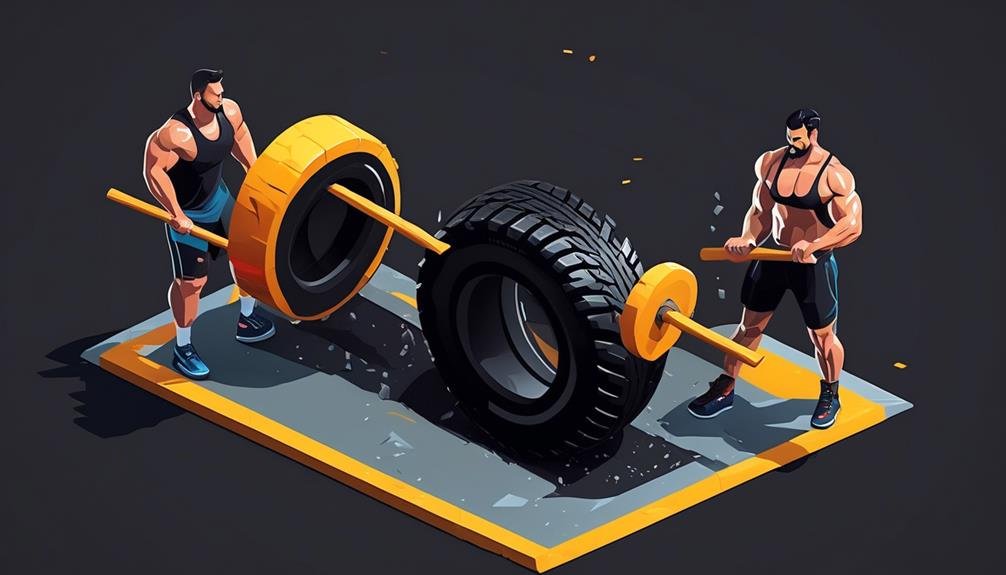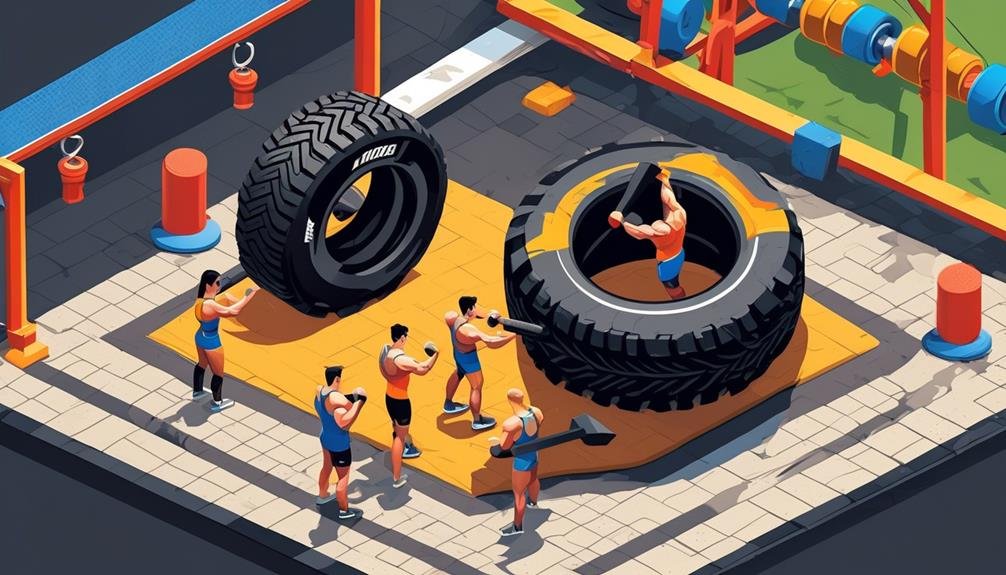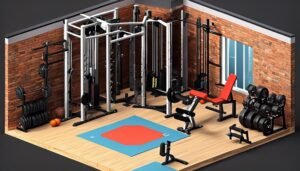So you're looking to take your fitness routine up a notch and add some functional training exercises like tire flips and sledgehammers? Well, you're in for a challenging yet rewarding experience.
But before you jump right in, there are a few things you need to know. From proper technique and safety tips to alternative exercises and progressions, this discussion will provide you with all the information you need to successfully incorporate these dynamic movements into your workouts.
Get ready to discover how tire flips and sledgehammers can transform your strength, coordination, and overall fitness.
Key Takeaways
- Functional training exercises like tire flips and sledgehammers improve overall athleticism and functional strength.
- Prioritize safety by warming up, starting light, using proper technique, and listening to your body to prevent injuries.
- Incorporate tire flips and sledgehammers into your workout routine by mastering foundational movements, gradually increasing weight, and diversifying your training.
- Combining tire flips and sledgehammers in a total body workout engages multiple muscle groups, focuses on technique, and includes a warm-up and variety for effectiveness.
Benefits of Functional Training Exercises
Functional training exercises offer a multitude of benefits, improving your overall athleticism, enhancing functional strength and balance, and engaging multiple muscle groups for a full-body workout. Incorporating exercises like Tire Flips, Tire Slams, and swinging a sledgehammer can help you develop functional strength, which is the ability to perform real-life movements and activities with ease. By mimicking these movements, functional training exercises improve everyday functionality and prepare your body for the demands of daily life.
Engaging in functional training exercises, such as Tire Flips, challenges your muscles and joints in a dynamic way. This not only helps prevent injuries by strengthening these areas but also improves your overall physical performance. The combination of compound movements and the use of different muscle groups during functional training exercises make it an efficient way to engage your entire body in one workout.
Functional training exercises like Tire Flips and swinging a sledgehammer also enhance your balance and stability. These exercises require you to engage your core muscles to maintain proper form and balance while performing the movements. As a result, you develop better stability and control over your body, which translates into improved performance in various activities.
Safety Tips for Tire Flips and Sledgehammers
Before attempting tire flips and sledgehammer exercises, it's important to follow these safety tips to prevent injuries and ensure a successful workout.
- Warm-up and stretch: Start with a dynamic warm-up to prepare your muscles for the intense strength training ahead. Dynamic stretching helps to improve flexibility and increase blood flow to the muscles, reducing the risk of injury.
- Start light and focus on technique: It's crucial to begin with a manageable weight and master the proper technique before progressing to heavier loads. This will help you build a solid foundation and minimize the risk of strain or muscle imbalances.
- Engage your core and maintain a neutral spine: To protect your back during tire flips and sledgehammer exercises, engage your core muscles and keep your spine in a neutral position. This will help distribute the load evenly and prevent unnecessary strain on your lower back.
Incorporating Tire Flips Into Your Workout Routine

To incorporate tire flips into your workout routine, start by mastering proper deadlift and squat form to build a solid foundation and prevent injury. These compound movements will help you develop the necessary strength and technique for tire flipping. Once you have mastered the basics, choose an appropriate weight below your deadlifting range to begin with. Gradually progress to heavier tires as you build strength and confidence.
Before starting your tire flipping session, it's essential to warm up your body. Perform exercises like plate halos and standing cable chops to activate your muscles and prepare them for the demands of tire flips. These warm-up exercises will help you improve your mobility and stability, reducing the risk of injury.
When incorporating tire flips into your workout routine, it's best to do them as part of a full-body workout. Consider using an AMRAP (as many rounds as possible) format to challenge yourself and boost your overall fitness and athleticism. This format allows you to perform a set number of tire flips within a specific time frame, pushing yourself to complete as many rounds as possible.
While tire flips are an excellent exercise for functional training, it's also important to diversify your training routine. Consider incorporating exercises like power cleans, sandbag clean and jerk, and box jumps to achieve similar results and keep your workouts interesting. By incorporating tire flips and other functional exercises, you can enhance your strength, power, and overall fitness in a contextually relevant manner.
Adding Sledgehammer Exercises to Your Fitness Program
Maximize the effectiveness of your fitness program by incorporating sledgehammer exercises that target your entire body. Adding sledgehammer exercises to your routine can help improve strength, endurance, and overall fitness. Here are three key tips to get you started:
- Learn proper technique: Before you begin, it's important to learn the correct form for sledgehammer swings. This will help prevent injuries and ensure you get the most out of your workout. Engage your core, keep your feet shoulder-width apart, and maintain a firm grip on the sledgehammer to maximize the effectiveness of each swing.
- Warm up properly: To prepare your body for sledgehammer workouts, warm up with exercises that target your core and upper body. Try exercises like plate halos and standing cable chops to activate your muscles and increase blood flow to the working areas.
- Vary your techniques: There are different techniques you can use for sledgehammer exercises to target different muscle groups. Experiment with standing side slams, kneeling side slams, and overhead slams to engage various muscles and keep your workouts challenging and effective.
Incorporating sledgehammer exercises into your fitness program can provide a unique and challenging full-body workout. Remember to start with proper technique, warm up adequately, and vary your techniques to maximize your results.
Combining Tire Flips and Sledgehammers for a Total Body Workout

Combine tire flips and sledgehammers to create a challenging and effective total body workout. This combination engages multiple muscle groups simultaneously, making it a great option for functional training. Not only does it build strength and power, but it also improves cardiovascular endurance and coordination.
To ensure safety and maximize effectiveness, it is important to focus on proper technique and form. Make sure to warm up with exercises like plate halos and standing cable chops to prepare your muscles and maintain a neutral back before starting sledgehammer workouts. This will help prevent injury and ensure that your core is engaged throughout the exercises.
Incorporating tire flips and sledgehammer workouts in an AMRAP (As Many Rounds As Possible) format can provide a fast and efficient total body workout. Here is an example of how you can structure your workout:
| Exercise | Reps | Sets | Rest |
|---|---|---|---|
| Tire Flips | 10 | 3 | 1 minute |
| Sledgehammer Swings | 20 (10 each side) | 3 | 1 minute |
In addition to tire flips and sledgehammer workouts, there are other exercises that can provide similar benefits. Consider incorporating sled work, power cleans, and medicine ball slams into your training routine to diversify your workouts and continue challenging your body.
Remember to gradually increase the weight and focus on proper form and technique for tire flips and sledgehammer swings. This will help you build strength safely and effectively. So grab a tire and a sledgehammer, and get ready to push your limits with this total body workout!
Scaling and Progressions for Functional Training Exercises
If you're looking to progress in your functional training exercises, it's important to focus on scaling and implementing proper progressions. Here are three key tips to help you scale and progress in your tire flipping workouts:
- Start with proper deadlift and squat form: Before attempting tire flips, make sure you have a solid foundation in deadlift and squat techniques. This won't only help prevent injury but also ensure that you're using proper movement patterns when flipping the tire.
- Begin with an appropriate weight: When starting tire flipping, choose a weight that you can manage comfortably. As your strength and technique improve, gradually increase the weight of the tire. This gradual progression will allow you to continue challenging yourself while maintaining proper form.
- Diversify training with alternative exercises: If tire flipping isn't feasible for you, don't worry! There are plenty of alternative exercises that can provide similar benefits. Consider incorporating power cleans, sandbag clean and jerks, battle ropes, or kettlebell swings into your functional training routine.
Common Mistakes to Avoid When Doing Tire Flips and Sledgehammers

To ensure a safe and effective tire flipping and sledgehammer workout, it's crucial to avoid common mistakes that can lead to injuries or reduced effectiveness.
One common mistake is using improper lifting technique. It's important to keep your back straight and lift through your legs, rather than relying on your arms. This helps prevent back injuries and ensures proper technique.
Another mistake to avoid is starting with too heavy of a weight. It's important to gradually increase the weight as your body strength and technique improve.
Neglecting warm-up exercises for your wrists, calves, and biceps is another common mistake. These warm-up exercises help prepare your muscles and joints for the demands of tire flipping and sledgehammer workouts, reducing the risk of strains or sprains.
Additionally, it's important to focus on proper coordination and control, rather than just power. This helps prevent accidents and ensures that you're getting the most out of the exercises.
Finally, avoid overestimating your capabilities and progressing too quickly to heavier tires or sledgehammer weights. Gradually increase the weight as your body adapts to the demands of the exercises to prevent overexertion and potential injuries.
Frequently Asked Questions
What Is an Alternative Exercise for Tire Flips?
You can try exercises like power cleans, sandbag clean and jerk, or kettlebell swings as alternatives to tire flips. These exercises mimic functional movements, engage multiple muscle groups, and can improve real-life performance. Remember to use proper technique to prevent injury.
What Kind of Exercise Is Tire Flipping?
Tire flipping is a full-body exercise that builds strength and endurance. It engages the quads, hamstrings, glutes, core, forearms, and improves grip strength. It mimics functional movements, enhancing real-life performance.
Is Sledge Hammering a Tire a Good Workout?
Yes, sledgehammering a tire is a great workout. It improves strength, endurance, coordination, and forearm strength. Make sure to warm up with plate halos and standing cable chops before starting.
What Muscles Do the Sledgehammer Work?
The sledgehammer primarily works your core, shoulders, forearms, and grip strength. The rotational and chopping motions engage your obliques, abs, and transverse abdominis. It also activates the deltoids, trapezius, back, chest, and legs for stabilization and support.
Conclusion
Incorporating functional training exercises like tire flips and sledgehammer workouts into your routine can greatly improve your strength, coordination, and overall fitness.
However, it's crucial to prioritize safety by mastering proper technique and warming up before attempting these exercises.
If you don't have access to the necessary equipment, explore alternative exercises that offer similar benefits.
Remember to scale and progress gradually to avoid common mistakes and maximize your results.
Get ready to take your fitness to the next level with these challenging and effective exercises.





